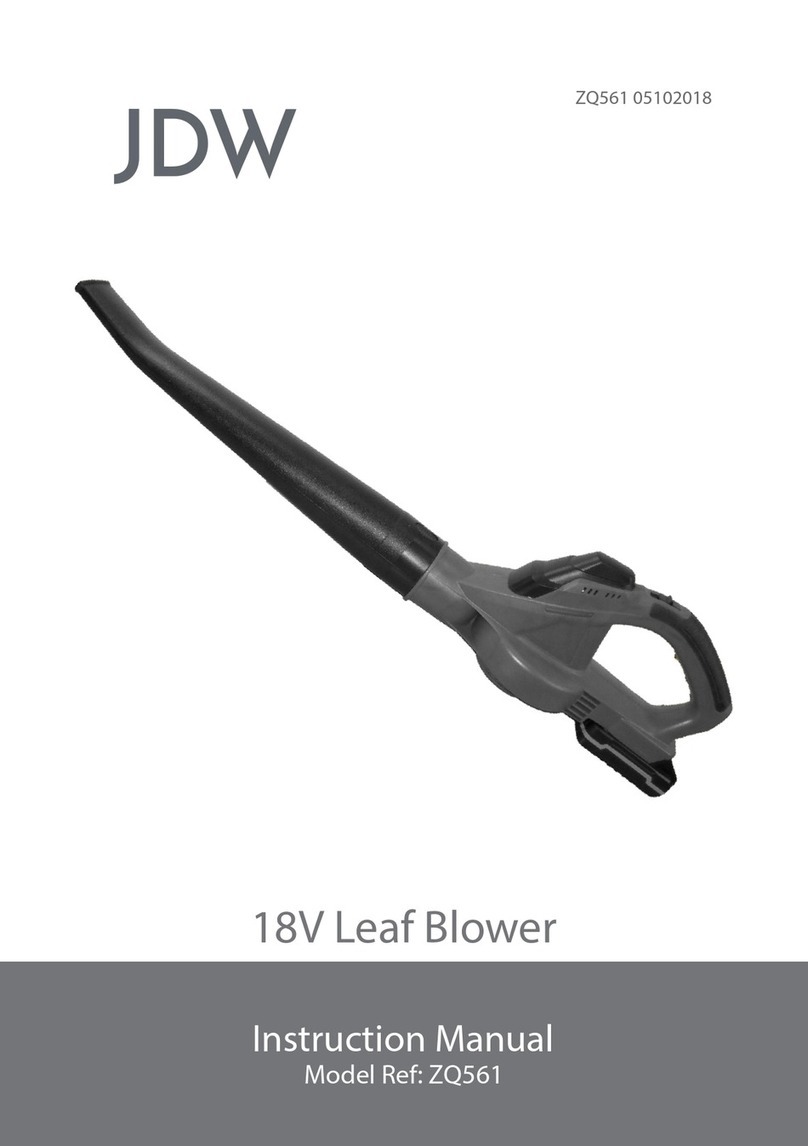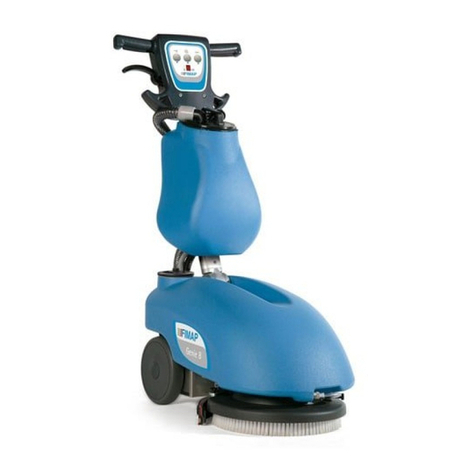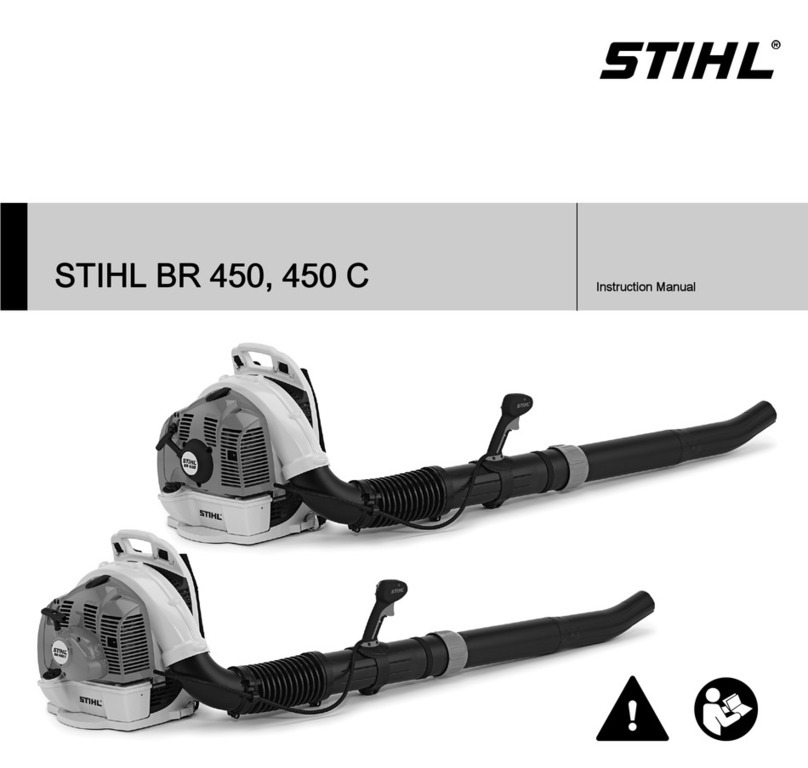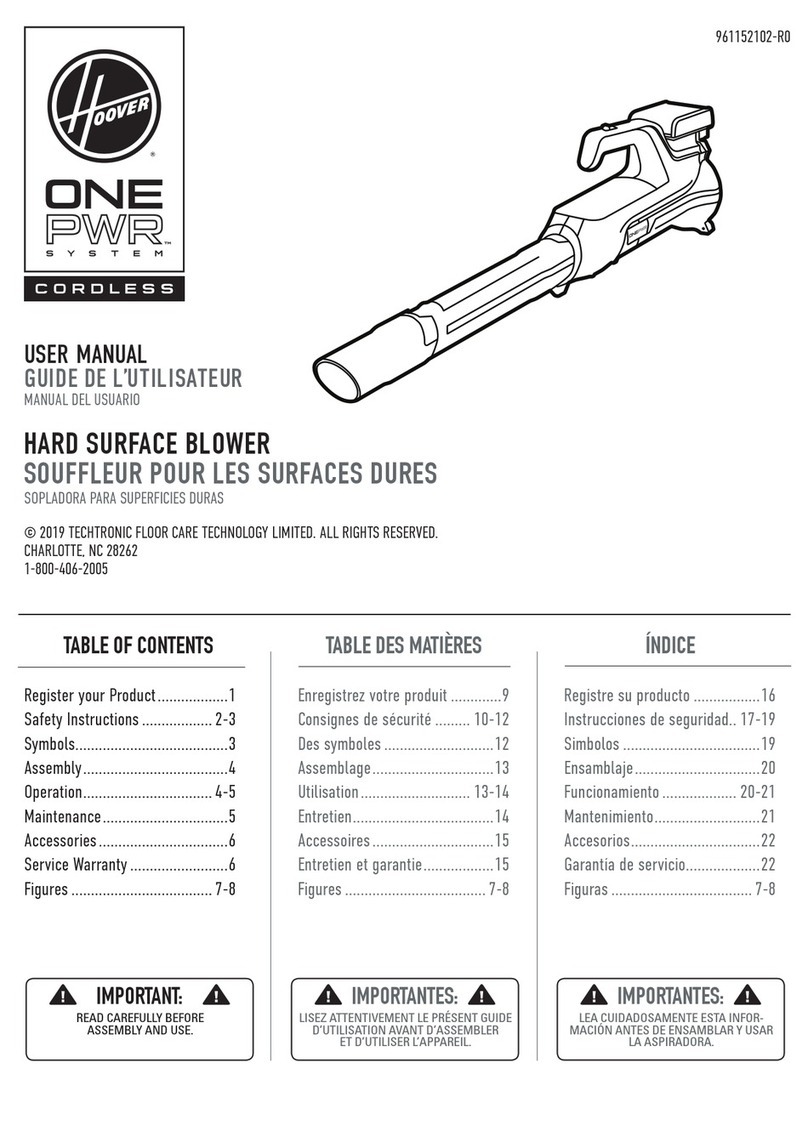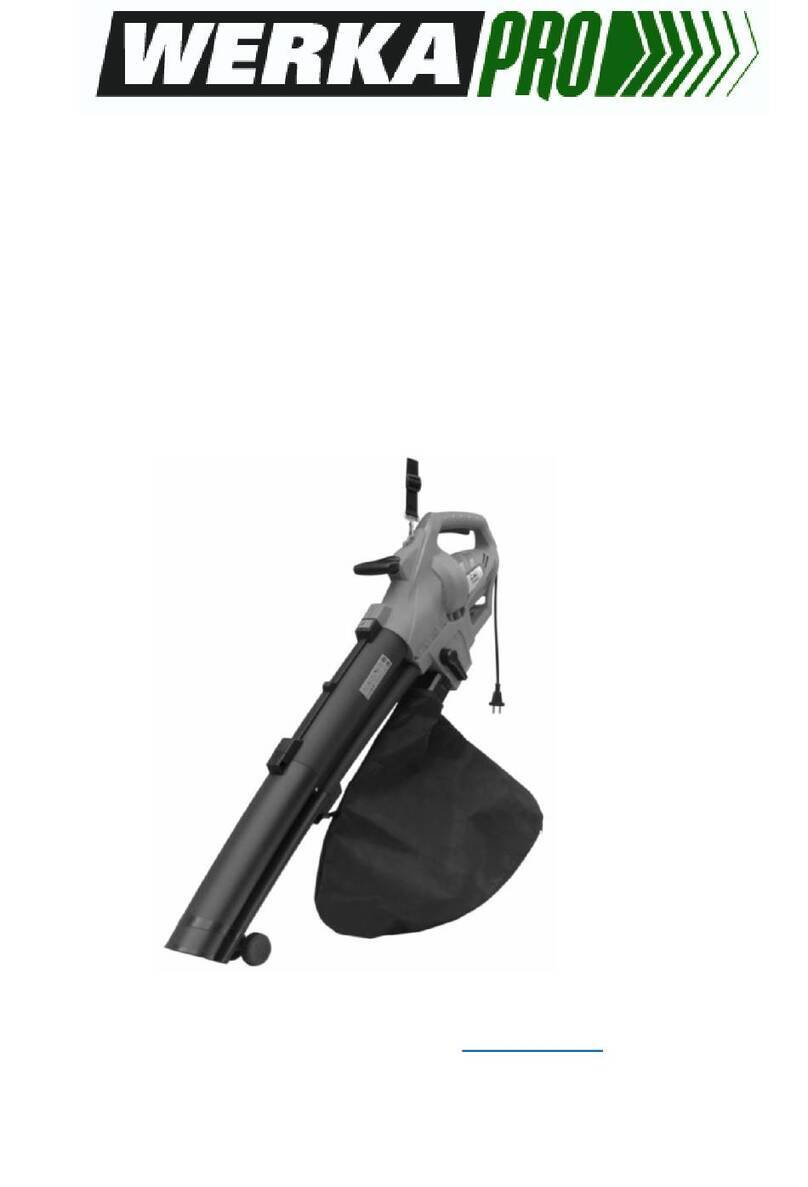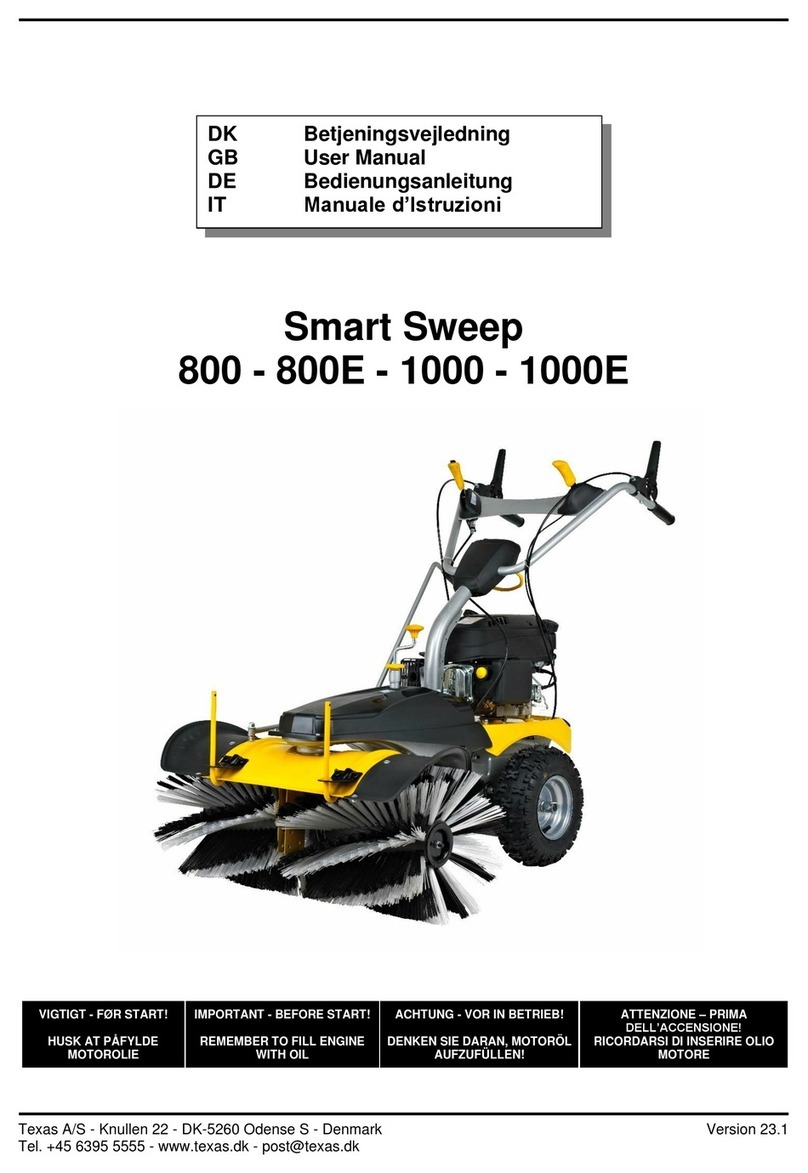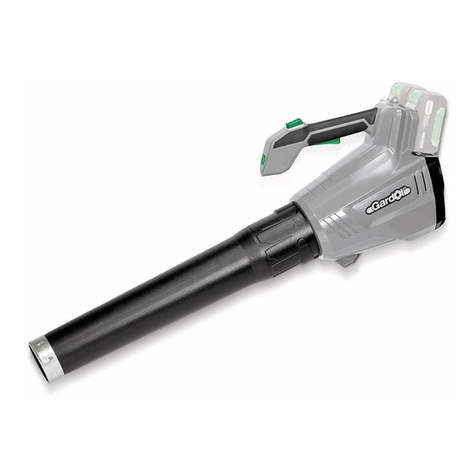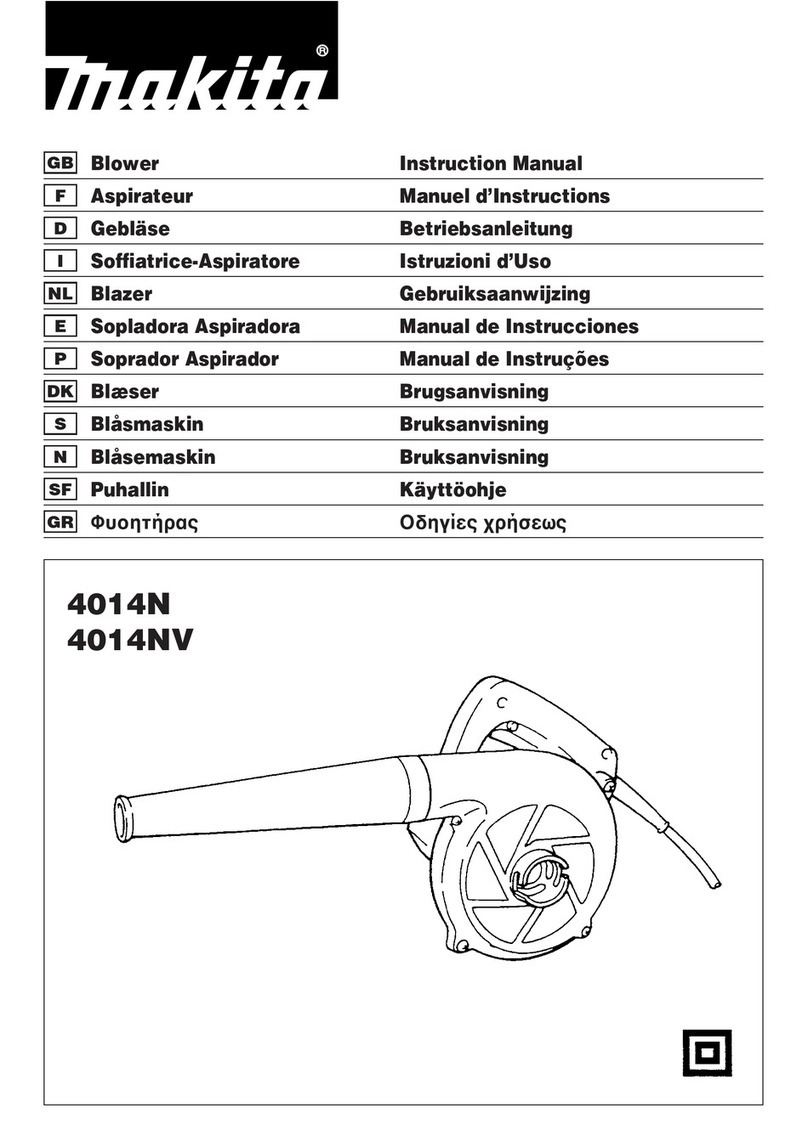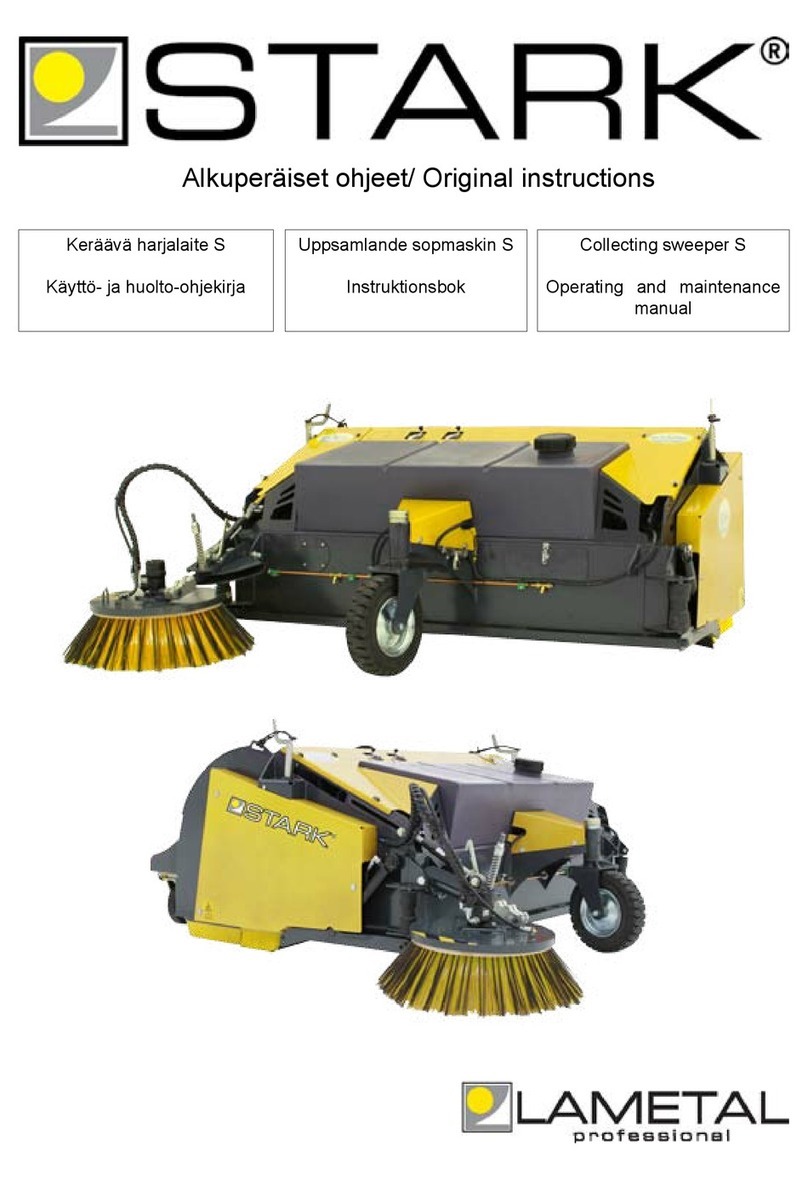JDW ZQ626 User manual

1
ZQ626 15102018
3000W Leaf Blower
Instruction Manual
Model Ref: ZQ626

01
INTRODUCTION
Thank you for choosing this Leaf Blower. This product is
manufactured to the highest standards of performance and
safety.
Before use, please read this manual carefully. It gives
important instructions about safety, use and maintenance of
your device.
Remove all packaging material. You may wish to keep
the packaging for future use or storage of your device.
Alternatively, dispose of accordingly.
CONTENTS
Introduction.........................................................01
Important Safety Information ............................02
Special Safety Requirements ...........................05
Product Overview...............................................06
Before First Use..................................................07
Using The Machine.............................................08
Maintenance, Cleaning and Storage.................09
Specication .......................................................10

02
IMPORTANT SAFETY INFORMATION
WARNING - Read all safety warnings and all instructions.
Failure to follow the warnings and instructions may result in
electric shock, re and/or serious injury. Save all warnings
and instructions for future reference. The term “power tool”
in the warnings refers to your mains-operated (corded)
power tool or battery-operated (cordless) power tool.
Work area safety
- Keep work area clean and well lit. Cluttered or dark areas
invite accidents.
- Do not operate power tools in explosive atmospheres,
such as in the presence of ammable liquids, gases or dust.
Power tools create sparks which may ignite the dust or
fumes.
- Keep children and bystanders away while operating a
power tool. Distractions can cause you to lose control.
Electrical safety
- Power tool plugs must match the outlet. Never modify the
plug in any way. Do not use any adapter plugs with earthed
(grounded) power tools. Unmodied plugs and matching
outlets will reduce risk of electric shock.
- Avoid body contact with earthed or grounded surfaces,
such as pipes, radiators, ranges and refrigerators. There is
an increased risk of electric shock if your body is earthed or
grounded.
- Do not expose power tools to rain or wet conditions. Water
entering a power tool will increase the risk of electric shock.
- Do not abuse the cord. Never use the cord for carrying,
pulling or unplugging the power tool. Keep cord away from
heat, oil, sharp edges or moving parts.

03
Damaged or entangled cords increase the risk of electric
shock.
- When operating a power tool outdoors, use an extension
cord suitable for outdoor use. Use of a cord suitable for
outdoor use reduces the risk of electric shock.
- If operating a power tool in a damp location is unavoidable,
use a residual current device (RCD with a tripping current
of 30 mA or less) protected supply. Use of an RCD reduces
the risk of electric shock. NOTE the term “residual current
device (RCD)” may be replaced by the term “ground fault
circuit interrupter (GFCI)” or “earth leakage circuit breaker
(ELCB)”.
Personal safety
- Stay alert, watch what you are doing and use common
sense when operating a power tool. Do not use a power tool
while you are tired or under the inuence of drugs, alcohol
or medication. A moment of inattention while operating
power tools may result in serious personal injury.
- Use personal protective equipment. Always wear eye
protection. Protective equipment such as dust mask, non-
skid safety shoes, hard hat, or hearing protection used for
appropriate conditions will reduce personal injuries.
- Prevent unintentional starting. Ensure the switch is in
the o-position before connecting to power source and/or
battery pack, picking up or carrying the tool.
Carrying power tools with your nger on the switch or
energizing power tools that have the switch on invites
accidents.
- Remove any adjusting key or wrench before turning the
power tool on. A wrench or a key left attached to a rotating
part of the power tool may result in personal injury.
- Do not overreach. Keep proper footing and balance at

04
all times. This enables better control of the power tool in
unexpected situations.
- Dress properly. Do not wear loose clothing or jewellery.
Keep your hair, clothing and gloves away from moving parts.
Loose clothes, jewellery or long hair can be caught in moving
parts.
- If devices are provided for the connection of dust extraction
and collection facilities, ensure these are connected and
properly used. Use of dust collection can reduce dust-related
hazards.
Power tool use and care
- Do not force the power tool. Use the correct power tool for
your application. The correct power tool will do the job better
and safer at the rate for which it was designed.
- Do not use the power tool if the switch does not turn it on
and o. Any power tool that cannot be controlled with the
switch is dangerous and must be repaired.
- Store idle power tools out of the reach of children and do
not allow persons unfamiliar with the power tool or these
instructions to operate the power tool.
Power tools are dangerous in the hands of untrained users.
- Maintain power tools. Check for misalignment or binding of
moving parts, breakage of parts and any other condition that
may aect the power tool’s operation. If damaged, have the
power tool repaired before use. Many accidents are caused
by poorly maintained power tools.
- Keep cutting tools sharp and clean. Properly maintained
cutting tools with sharp cutting edges are less likely to bind
and are easier to control.
- Use the power tool, accessories and tool bits etc. in
accordance with these instructions, taking into account the
working conditions and the work to be performed.

05
Service
- Have your power tool serviced by a qualied repair person
using only identical replacement parts. This will ensure that
the safety of the power tool is maintained.
SPECIAL SAFETY REQUIREMENTS
For outdoor use only. Do not use when it is raining. Check
that the ventilation slots are not blocked. Always use ear
protectors, protective goggles, overalls and safety footwear
when using the hedge
blower. Do not allow other people or animals to come within a
radius of 3 meters of the
blower while it is running. Remember that noise from the
blower can prevent you from hearing warnings etc. Be aware
of your surroundings when you are using the blower.
Keep ngers and hands safely away from the blade while
using the blower.
Do not obstruct or in any other way prevent the safety switch
from working, e.g., in order
to use the blower with one hand only.
Always remove the battery from the blower after use, before
removing objects stuck in
the blade and when cleaning the blower.
Never put the blower down before it has completely stopped
running. The blade continues to run a short time after the
machine has been switched o. A sturdy pair of work gloves
can reduce vibrations in your hands.
Never walk around with the blower while it is running.
Always t the protective sleeve onto the blade when
transporting or storing the blower.

06
PRODUCT OVERVIEW
1
2
3
4
5
6
7
8
9
1. Wheel
2. Blower/Vacuum Tube
3. Blower/Vacuum Body
4. Auxilary Handle
5. Hole For Belt Hook
6. Shoulder Belt
7. Switch Trigger
8. Blower/Vacuum Selector Lever
9. Collection Bag

07
BEFORE FIRST USE
WARNING!
The Vac-Blower must not be used or switched on until it
has been fully assembled.
- Insert tube 2-2 into tube 2-1 forcibly. Fasten the screw until
they connect well (Fig. 3). Then put the whole tube into the
machine body and secure xed by other two provided screw,
see Fig. 4. Please note one with a short special screw, one is
an ordinary longer screw.
Fig 3. Fig. 4
- Do not attempt to pick up wet debris, allow fallen leaves etc,
to dry out before using the Vacuum Blower.
- The Vacuum-Blower can be used to blow debris from patios,
paths, driveways, lawns, bushes and borders. It will also pick
up leaves, paper, small twigs and wood chippings.
- When the using the Vacuum-Blower in Vacuum mode, the
debris is sucked up through the suction tube before being
ejected into the debris collection bag, as the debris passes
through the suction fan it is partially shredded. The shredded
organic debris is ideal to use as mulch around plants.
WARNING! ANY HARD OBJECTS, SUCH AS STONES, TIN
CANS GLASS ETC, WILL DAMAGE THE SUCTION FAN.

08
IMPORTANT
- Do not use the Vacuum-Blower to suck up water or very wet
debris.
- Never operate the Vacuum-Blower without the debris collection
bag tted.
USING THE MACHINE
Blower mode
Inspect the area to be worked before starting. Remove any
objects or debris that could be thrown, jammed or become
entangled in the Vacuum-Blower.
Select the blow function using the selector lever on the side of
the machine (Fig.7) and switch on. With the Vacuum- Blower
resting on its wheels, move the Vacuum-Blower forwards
directing the nozzle at the debris to be cleared.
Alternatively hold nozzle just above the ground and swing
the machine from side to side, moving forwards and directing
the nozzle at the debris to be cleared. Blow the debris into a
convenient heap then use the vacuum function to collect the
debris.
Fig. 7
Fig. 8

09
MAINTENANCE, CLEANING AND STORAGE
Warning! Before carrying out any checks or maintenance
operations, disconnect the plug from the electric power supply.
- Check your machine regularly before starting the work. Make
sure that all nuts, bolts and screws are tight and that the guards
are tted correctly.
- All damaged and worn parts should be replaced in order to
maintain the Vacuum-Blower in a safe working condition.
- Never leave material in the Vacuum-Blower or the debris
collection bag. This could be dangerous when starting the
Vacuum-Blower.
- After use the Vacuum-Blower should be thoroughly cleaned.
Ensure that the Vacuum-Blower is switched o and disconnected
from the mains supply. Remove and empty the debris collection
bag. Ensure that the Vacuum / Blow selector lever operates
smoothly and that it is not obstructed by debris. Brush any loose
debris from around the fan and inside the suction/blower tube.
- Always keep the ventilation slots in motor housing clean.
- Never clean or spray a machine with water. Clean the motor
housing only with a moist cloth and never use detergents or
solvents! These could ruin the plastic parts of the machine.
Finally, dry the motor housing carefully.
- Store the appliance in a dry place, out reach of children.
if the replacement of the supply cord is necessary, this has to be
done by the manufacturer or his agent in order to avoid a safety
hazard.
WARNING: FOR YOUR OWN SAFETY THIS BLOWER & VAC.
IS DOUBLE INSULATED, TO AVOID ELECTRICAL SHOCK,
FIRE, OR INJURY, USE ONLY PARTS IDENTICAL TO THOSE
IN THE PARTS LIST. REASSEMBLE EXACTLY AS THE
ORIGINAL ASSEMBLY TO AVOID ELECTRICAL SHOCK.

10
SPECIFICATION
Model No.
DT2201A,DT2202A,DT2203A,
DT2204A,DT2205A,D2206A,
DT2200A
Voltage / Frequency 220V-240V~ , 50Hz
Input Power 1800W/2000W/2400W/2500W
2600W/2800W/3000W
No Load Speed 15,000/min
Max. air speed: 270KM/H 270km/h
Max. air volume 13.2m³/min
Collection bag 35L
Mulching rate 10 : 1
Net Weight 3.0kg
Sound pressure level(in
accordance with EN 50636-2-
100)
83.54dB(A) K=3dB
Sound power level(in
accordance with EN 50636-2-
100)
101.08dB(A) K=3dB
Guaranteed sound power level
(in accordance with 2000/14/
EC, amended by 2005/88/EC)
105dB(A)
Vibration(in accordance with EN
50636-2-100) 7.655m/s2 K=1.5m/s2

11
DISPOSAL INFORMATION
IMPORTANT INFORMATION FOR CORRECT DISPOSAL
OF THE APPLIANCE IN ACCORDANCE WITH EC
DIRECTIVE 2002/96/EC
At the end of its working life, the Pressure Washer must NOT
be disposed of as urban waste.
It must be taken to a special local authority dierentiated
waste collection centre or to a dealer providing this service.
Disposing of a household appliance separately avoids
possible negative consequences for the environment and
health deriving from inappropriate disposal and enables the
constituent materials to be recovered to obtain signicant
savings in energy and resources. As a reminder of the need
to dispose of household appliances separately, the product is
marked with a crossed-out wheeled dustbin.

JD Williams Ltd.
Manchester, UK, M60 6ES
M606ESO1
Table of contents
Other JDW Blower manuals
